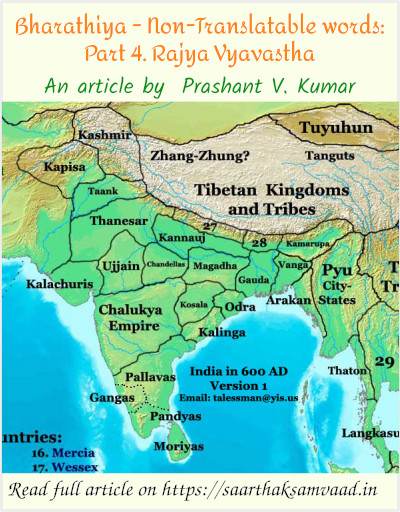Before the forcing of Democracy upon the people of Bharat, most scholars and historians say that Bharat was a country ruled by small kings with small kingdoms and they were always fighting with each other, but when we look at history without any tainted glasses, we find that this is not the case. It is very important to understand the political structure of Bharat. Before going into that, here are some words and terminologies with respect to the Neeti Vyavastha – the political system of Bharat.
26. Raja (राजा): This word Raja is usually translated as King. Now let us see what the definition of King is; King is the title given to the supreme ruler of a country, who holds his position because of his birth in a royal family. Now compare it with Raja; Ra as described earlier stands for light meaning knowledge and Ja is born out of. Hence a Raja is the one who is born out of knowledge, not someone who is decided by birth in a royal family. There are many instances in Bharathiya Ithihaasa where the Raja has been overthrown by the Praja and a new Raja from a totally new family has been made Raja. And he is not the ‘Supreme Ruler’ he takes the role of the ‘Pratham Sevak’ (See Ramayan Sugriva Rajyabhishek).
27. Maharaja (महाराजा): The description for Maharaja can be found at the bottom of this article.
28. Praja (प्रजा): This word is translated as citizen in a wrong way. Citizen is a person who is legally accepted member of a country who lives in a city, town or village in the same country. The meaning of Praja is actually the children of the Raja. And the relation between the Raja and Praja is like that of a father and children. Praja perform their responsibilities towards the ‘Desha’ (देश) and the Raja just like the children perform theirs to their father and the home.
29. Chakravarthy or Samrat (चक्रवर्ती / सम्राट): The translations for these words have been Emperor. Emperor is a monarch or a ruler who is the supreme imperator (Commander) over many a Kings. Samrat or Chakravarthy don’t have any of these powers. As the name suggests ‘Chakravarthy’ has ‘Chakra’ in it suggesting that this title was not permanent it would change in rotation. You will find many Rajas or Maharajas who have done what is known as “Rajasuya Yagjna” to acquire the title “Chakravarthy” and thereafter the area they ‘Rule’ is known as ‘Samrajya (साम्राज्य)’. Of course the Chakravarthy had many Maharajas and Rajas under him but they had their independence to function on their own and these Rajyas were Autonomous.
30. Kshetrapal (क्षेत्रपाल) or Savant (सावंत) or Samanth (सामंत) or Palegar: Many people translate this as Satraps. Satraps are provisional governors or subordinates to a local King and they are basically tax collectors for their kings. Satraps were people who had some kind of political leverage to get them appointed. Kshetrapal as the name suggests – takes care of or protects a province reporting to a Raja. He is usually either appointed by Raja or in most cases selected by the local people. The word Satrap though has originated from Kshetrapal, but there is a big difference between the two.
Let us understand briefly the political structure of Bharat before the British took over. The country had 4 – 6 Chakravarthis. The area which they protected was called Samrajya and they used to have a council of their own. Then we had 56 Maharajas who were crowned in the 56 Manajanapadas and they had their council too. Then we had 108 Rajas who ruled over 108 Janapadas, the Rajas had a regional council. Then we had the 365 Khandas which were protected and governed by the Kshetrapals / Savant / Samant / Palegar who had a council under their respective Raja.
Then in the following order came the Pattedars, Mandalesh, Pattabhaj, Praharaka, Ashtaganin and Shanbog. The Shanbog was the head of the village, Ashtagranin was the head of eight villages, Praharaka was the head of 5-6 Ashtagranins, Pattabhaja was the head of 5 Praharakas, Mandalesh was the head of a Mandal which consisted of like 200 villages and the Pattedars would head 5-6 Mandaleshas and about 10 Pattedars would report to a Kshetrapal or Savant.
And in our history classes we are given to understand that we as a country were ruled by small Kingdoms who fought wars with each other over their borders!!! Yes, there would be some small fights here and there over the bordering areas but they were resolved in the respective councils or sometime they would escalate into a small physical fight which can’t be considered as ‘war’, because the local council or the local people would sort it out.


Leave a Reply